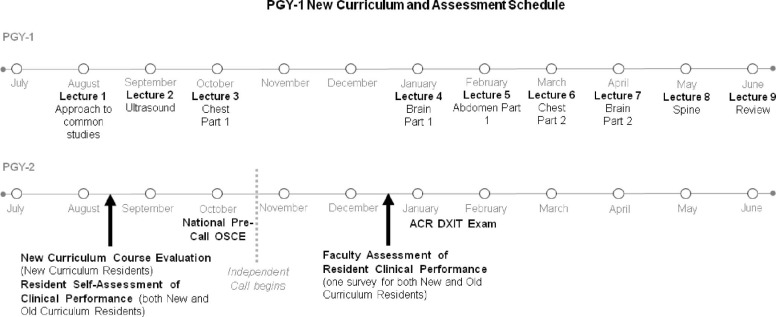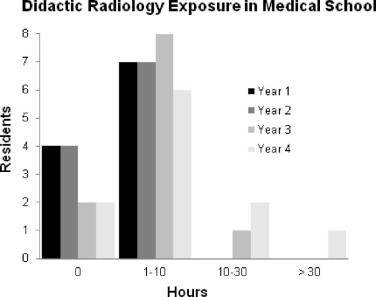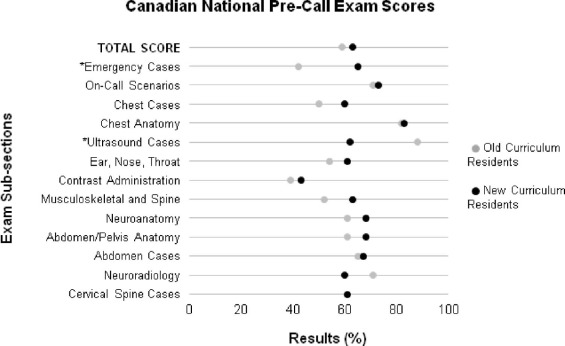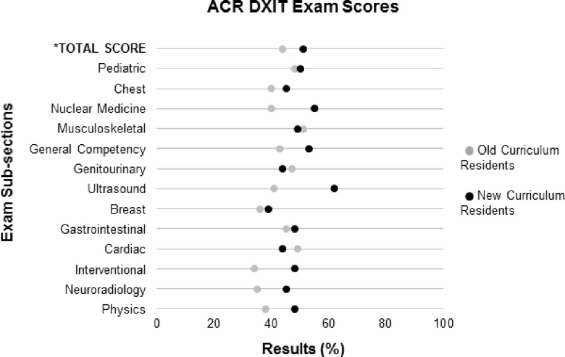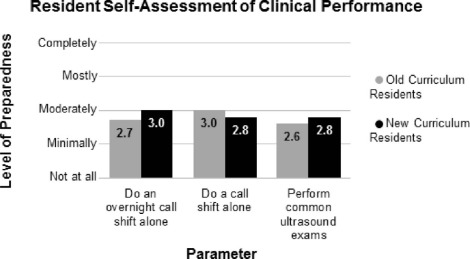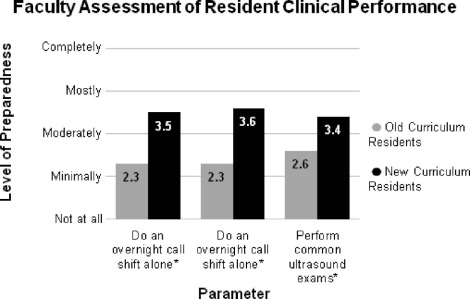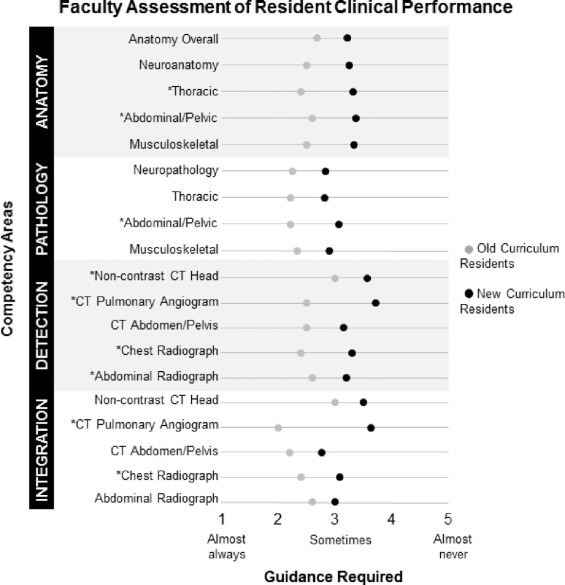Rationale and Objectives
In order to ease the transition from internship to diagnostic radiology residency, a year-long didactic introduction to radiology course was offered to post-graduate year one (PGY-1) diagnostic radiology residents during their internship, which consisted of 27 hours of lecture over 9 months. The purpose of this study was to determine the quantitative and qualitative educational value of this course and its effect with respect to on-call preparedness.
Materials and Methods
Two consecutive cohorts of Diagnostic Radiology residents were included: the first cohort (PGY-1s in 2011–2012) did not participate in the new course (Old Curriculum Residents) and the second cohort (PGY-1s in 2012–2013) completed the new course (New Curriculum Residents). These two cohorts were compared both qualitatively and quantitatively. Scores were compared from the standardized Canadian National Pre-Call Observed Standardized Clinical Examination and American College of Radiology Diagnostic Radiology In-Training examination, which are taken in the PGY-2 year, at months 5 and 7, respectively. In addition, staff observation of on-call resident performance and resident self-reported preparedness were considered. Cohorts were compared using Mann-Whitney U test with significance defined as P value <0.05. P values from 0.05 to 0.10 were noted as possibly significant and further analyzed using a Cohen d test where the difference was determined to be small (0.2), medium (0.5), or large (0.8).
Results
New Curriculum Residents reported that the content of the PGY1 curriculum was more appropriate than the old curriculum to prepare them for call in PGY2 ( P = 0.013). New Curriculum Residents scored better than the Old Curriculum Residents on the Diagnostic Radiology In-Training examination ( P = 0.039) and on the emergency cases of the Canadian National Pre-Call Observed Standardized Clinical Examination ( P = 0.035). Staff radiologists, who were not blinded, reported that the New Curriculum Residents were better prepared for daytime ( P = 0.006) and overnight (P = 0.008) independent call were better prepared to perform common ultrasound examinations alone ( P = 0.049), and required less guidance while on call for nine competency areas. There was, however, no statistical difference between the residents’ self-reported preparedness for independent call.
Conclusions
Participation in a lecture-based introductory radiology curriculum during the PGY-1 internship year improved both radiology residents’ preparedness for call and their performance in PGY-2.
Introduction
The transition from internship to radiology residency is challenging. This adjustment is also made more difficult by the added pressure to prepare for independent call, which has become more demanding over the last decade . While on call, residents are expected to perform a diverse range of examinations from routine cross-sectional imaging to fluoroscopic-guided interventions . Although staff radiologists are available, residents must still be comfortable with clinical scenarios that require imaging, and attendant knowledge of appropriateness criteria, study protocols, and emergent on-call pathologies.
Several solutions have been proposed to ease the transition from internship into radiology residency. These educational initiatives focus primarily on alleviating the anxiety of independent call and include pre-call examinations, simulations, and web-based applications . These solutions, however, primarily emphasize “on-call” pathology (eg, aortic dissection, pulmonary embolism, etc.) and do not address the basics of image interpretation, anatomy, and foundational non-emergent pathology. To ease the transition into radiology residency, the Diagnostic Radiology Residency Program at the University of British Columbia introduced a formal lecture-based course for post-graduate year one (PGY-1) residents to attend during their internship year.
Get Radiology Tree app to read full this article<
Get Radiology Tree app to read full this article<
Materials and Methods
Study Population
Get Radiology Tree app to read full this article<
New Curriculum Course Design
Get Radiology Tree app to read full this article<
Get Radiology Tree app to read full this article<
Get Radiology Tree app to read full this article<
New Curriculum Course Evaluation
Get Radiology Tree app to read full this article<
Resident Academic Performance Assessment
Get Radiology Tree app to read full this article<
Get Radiology Tree app to read full this article<
Get Radiology Tree app to read full this article<
Resident Self-Assessment of Clinical Performance
Get Radiology Tree app to read full this article<
Get Radiology Tree app to read full this article<
Faculty Assessment of Resident Clinical Performance
Get Radiology Tree app to read full this article<
Statistical Analysis
Get Radiology Tree app to read full this article<
Results
Study Population
Get Radiology Tree app to read full this article<
Get Radiology Tree app to read full this article<
New Curriculum Course Evaluation
Get Radiology Tree app to read full this article<
Resident Academic Performance Assessment
Get Radiology Tree app to read full this article<
Get Radiology Tree app to read full this article<
Resident Self-Assessment of Clinical Performance
Get Radiology Tree app to read full this article<
Get Radiology Tree app to read full this article<
Faculty Assessment of Resident Clinical Performance
Get Radiology Tree app to read full this article<
Get Radiology Tree app to read full this article<
Get Radiology Tree app to read full this article<
Discussion
Get Radiology Tree app to read full this article<
Get Radiology Tree app to read full this article<
Get Radiology Tree app to read full this article<
Get Radiology Tree app to read full this article<
Get Radiology Tree app to read full this article<
Get Radiology Tree app to read full this article<
Get Radiology Tree app to read full this article<
Acknowledgements
Get Radiology Tree app to read full this article<
Appendix 1
Get Radiology Tree app to read full this article<
Get Radiology Tree app to read full this article<
Appendix 2
Get Radiology Tree app to read full this article<
Get Radiology Tree app to read full this article<
References
1. Chokshi F.H., Hughes D.R., Wang J.M., et. al.: Diagnostic radiology resident and fellow workloads: a 12-year longitudinal trend analysis using National Medicare Aggregate Claims Data. J Am Coll Radiol 2015; 12: pp. 664-669.
2. Herron J., Reynolds J.H.: Trends in the on-call workload of radiologists. Clin Radiol 2006; 61: pp. 91-96.
3. McDonald J.M., Berbaum K., Bennett D.L., et. al.: Radiology residency call: residents’ perceptions of the on-call experience. J Am Coll Radiol 2005; 2: pp. 932-938.
4. Scott J.N., Romano C.C.: On-call services provided by radiology residents in a university hospital environment. Can Assoc Radiol J 2003; 54: pp. 104-108.
5. Drexler I.R.: One night in the ED. J Digit Imaging 2015; 28: pp. 386-388.
6. Khan R., Krupinski E., Graham J.A., et. al.: Assessing first year radiology resident competence pre-call: development and implementation of a computer-based exam before and after the 12 month training requirement. Acad Radiol 2012; 19: pp. 752-758.
7. Towbin A.J., Paterson B., Chang P.J.: A computer-based radiology simulator as a learning tool to help prepare first-year residents for being on call. Acad Radiol 2007; 14: pp. 1271-1283.
8. Trout A.T., Wang P.I., Cohan R.H., et. al.: Apprenticeships ease the transition to independent call: an evaluation of anxiety and confidence among junior radiology residents. Acad Radiol 2011; 18: pp. 1186-1194.
9. The Royal College of Physicians and Surgeons of Canada (RCPSC) : Speciality Training Requirements in Diagnostic Radiology.2014.The Royal College of Physicians and Surgeons of CanadaOttawa
10. Brant W.E., Helms C.A.: Fundamentals of diagnostic radiology.4th ed.2012.Wolters Kluwer/Lippincott Williams & Wilkins HealthPhiladelphia
11. American College of Radiology : DXIT™ & TXIT™ In-Training Examinations. Available at: http://www.acr.org/Education/Exams-Certifications/DXIT-TXIT Accessed February 14, 2016
12. Baumgartner B.R., Peterman S.B.: Relationship between American College of Radiology in-training examination scores and American Board of Radiology written examination scores. Acad Radiol 1996; 3: pp. 873-878.
13. Orton T.H., McInnes M.: Can American College of Radiology in-training examination scores be used to predict Canadian radiology licensing examination results? A retrospective study. BMC Med Educ 2013; 13: pp. 17.
14. Peterson L.N., Eva K.W., Rusticus S.A., et. al.: The readiness for clerkship survey: can self-assessment data be used to evaluate program effectiveness?. Acad Med 2012; 87: pp. 1355-1360.
15. Forster B.B., Whittall K.P.: Stress in Canadian radiology residency training: a national survey. Can Assoc Radiol J 1998; 49: pp. 349-350.
16. Davenport M.S., Ellis J.H., Khalatbari S.H., et. al.: Effect of work hours, caseload, shift type, and experience on resident call performance. Acad Radiol 2010; 17: pp. 921-927.
17. Flink C.C., Mueller J.S., Kiproff P.M.: Impact of resident call eligibility on major discrepancy rate. Acad Radiol 2010; 17: pp. 1299-1301.
18. Berger W.G., Gibson S.W., Krupinski E.A., et. al.: Proposed ACGME change in length of radiology residency training before independent call: results of a survey of program directors and chief residents. J Am Coll Radiol 2007; 4: pp. 595-601.
19. Gunderman R.B., Tobben J.P.: Is it time to Jettison radiology’s clinical year requirement?. Acad Radiol 2016; 23: pp. 389-391.
